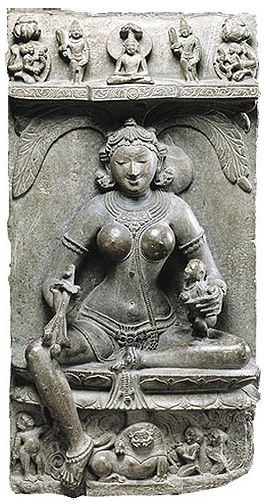return to Home Page
or move on to Goddess Astart, next chronologically,
or use Her Cyclopedia Index
Ambika, Mother
1MBEK1
Alternate meaning: Little-Mother.
[to Whom the ninth day of December, day 343, is dedicated]

Geography/Culture: Hindustani: Jain.
Linguistic Note: see Amba's linguistic note below.
Description: Goddess of nature, especially Autumn and the harvest; Genetrix; She Whose concern is water conservation and water controlled for use by people; Genitrix and tutelary deity of the Jains; Defeater of demons; She Who assumes the form of Autumn in order to destroy beings through fever and other autumnal diseases; She Who gives Her name {in what Hindustani language(s)?} to autumn as the most productive season; Ruler of the emotions; She Who is to be propitiated at the height of the harvest season, and to be worshiped before digging water-tanks.
To Whom Sacred: animal and human sacrifice; the forehead (seat of the emotions especially of wrath; She gave birth to Kali, Black-One, from Her head); water-reservoirs; grains and fruits.
Titles/Variants, etc:
- No doubt etymologically related to Amba, Mother, below.
- Balambika, Girl-Mother, may be a form of Her, below.
- A form of, and alternate name for, Durga, Inaccessible-One.
- A title of Gauri, Brilliant-White.
- Hemambika, Golden-Mother, may be a form of Her, below.
- Mother, and title, of Kali, Black-One, Who was born from Her head.
- Mukhambika, Mouth-Mother, may be a form of Her, below.
- A title of Parvati, She-of-the-Mountains, Who is linked with Uma, Gracious-One.
- One of Her titles is Sakambhari, Herb-Bearing, below.
- Ambika, Mother, is also a title of Uma, Gracious-One, Herself.
Amba, Mother.
1MB*
Geography/Culture: Hindustani.
Linguistic Note: In southern Indian languages amba becomes amma and is frequently affixed to names of Goddesses and females in general. It is also a common name for Dravidian Mother Goddesses and may be that from which Uma's name is derived. Compare with German Amme, nurse; Old German, amma.
Titles/Variants, etc:
- Variant
Amma.
- Title or alternate name for Durga, Inaccessible-One.
- Perhaps origin of Norse Amma, Grandmother, Who is linked with Edda, Great-Grandmother.
Source: Stutley HDH 11, 311.
Amma, Grandmother.
1M1
Geography/Culture: Hindustani.
Titles/Variants, etc:
- The name of one of the seven Krttikas, ----, Who are linked with Ganga, Swift-Goer.
- See also Gauri, Brilliant-White.
Balambika, Girl-Mother.
B*L*MBYK*
Geography/Culture: Hindustan, South: tantric.
Titles/Variants, etc:
- Identical with
Kanya-Kumari, K1NY*-KWM*RE, ----, the divinity of Cape Comorin. Linguistic Note: Kumari is the name of one of the seven holy rivers that wash away sin. Kanya means -- the Virgin.
Hemambika, Golden-Mother.
H]M*MBYK*
Geography/Culture: Hindustan: Tantric. She has a shrine in Palghat, South Malabar.
Description: She is represented, not as a figure, but by a pair of hands protruding from a miniature well. Legend attributes this form to the "lewd attentions" of the priestly ministrant responsible for ritually bathing Her.
Titles/Variants, etc:
- See also Sakti, Divine-Energy.
- She is associated with: Balambika, Girl-Mother, above.
- And associated with Mukambika, Mouth-Mother, below.
Source: HDH 37, 111.
Mukhambika, Mouth-Mother.
MWKH*MBYK*
Geography/Culture: Hindustan. She has a shrine in North Cannanore on the Malabar coast.
Description: Only the lower portion of the Goddess's head is depicted.
Sakambhari, Herb-Bearing.
S*K1MBH1RE
Alternate meaning: Herb-Nourishing.
Geography/Culture: Probably of pre-Vedic origin.
It may be She Who is portrayed, upside-down, naked, with a plant issuing from Her womb on an oblong Harappan seal.
Description: Goddess of vegetation; She Who from Her body produces the life-sustaining vegetables.
Iconography: An oblong Harappa seal depicts a nude female figure, upside down, from whose womb issues a plant. A similar Gupta terracotta figure has a lotus issuing from Her neck.
Titles/Variants, etc:
- Title of Ambika, Mother, above.
- Subsequently identified with Durga, Inaccessible-One.
- Alternate name for Parvati, She-of-the-Mountains, Who is linked with Uma, Gracious-One.
- Sakambhara, ----, would appear to be a variant but see Sitala, ----, Who is linked with Jyestha, Elder-Sister.
- Alternate name for Uma, Gracious-One.
Source: BGH/14; HDH/11, 37, 111, 155, 195, 222, 258-9, 260; NLEM/347 (image...Steatite, 11th cent. A.D. from the Jain temple at Orissa), 375.
worked on: November, September, May 1995; June 1992; August 1991; July 1990.
Return to the top of this document.
